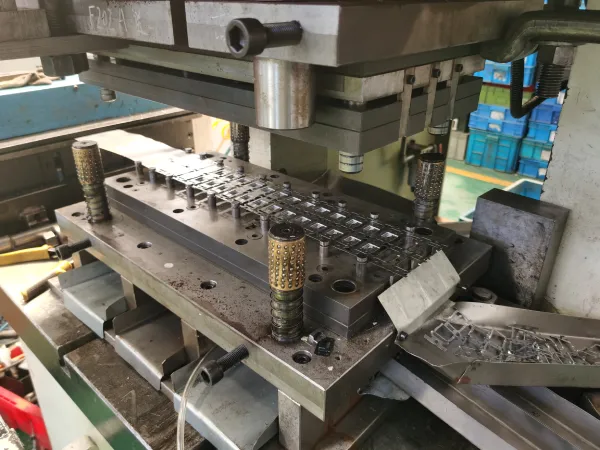The Evolution of Metal Stamping Procedures: Technologies and Applications
The world of steel stamping processes has witnessed a transformative trip noted by constant innovation and adaptation to satisfy the demands of modern-day industrial techniques. The applications extend across a spectrum of markets, each benefiting distinctively from the improvements in steel marking procedures.
Typical Metal Stamping Techniques
Conventional steel stamping methods have actually long been the foundation of manufacturing processes in different markets because of their efficiency and precision. The process entails creating a metal sheet or coil into a preferred shape by pushing it in between a die and a strike. This method is extensively made use of for creating large amounts of get rid of high precision at a quick pace.
Among the crucial benefits of typical metal stamping strategies is the capability to keep limited resistances, ensuring that each part meets the needed specs consistently. This degree of accuracy is essential in markets such as automotive, aerospace, and electronics, where even small deviations can cause substantial problems.
Furthermore, typical steel marking strategies offer cost-efficient services for automation compared to various other producing methods. The capacity to stamp components in quick succession decreases manufacturing time and reduces labor costs, making it an eye-catching option for services aiming to enhance their production processes.
Emergence of High-Speed Stamping

Among the essential advantages of high-speed marking is its capability to maintain precision and consistency also at accelerated processing speeds. This precision is critical in sectors where limited tolerances and elaborate styles are needed. Additionally, high-speed marking permits for the handling of a vast array of products, consisting of aluminum, stainless steel, and copper, additional broadening its applicability throughout numerous markets.
Furthermore, the emergence of high-speed stamping has made it possible for suppliers to satisfy the growing need for complicated components in markets such as automotive, aerospace, and electronic devices (Metal Stamping). By leveraging the speed and accuracy of high-speed marking modern technology, business can improve their competition in a rapidly advancing market landscape
Developments in Tooling Technology
With the advancement of high-speed marking enabling boosted accuracy and performance in metal forming processes, the area of steel marking has actually seen significant innovations in tooling modern technology. Tooling innovation plays a crucial role in steel marking procedures, influencing elements such as product high quality, production speed, and general cost-effectiveness.
Furthermore, advancements in products science have brought about the production of tooling materials with anonymous improved toughness, use resistance, and thermal conductivity. By utilizing these innovative materials, tooling makers can generate passes away and mold and mildews that hold up against the high stress and temperatures involved in metal stamping procedures, causing longer device life and improved manufacturing effectiveness. In addition, innovations in device layout, such as the usage of simulation software and additive production methods, have actually enabled the creation of complex tooling geometries that were formerly testing to generate. Generally, these innovations in tooling technology have transformed the metal marking industry, enabling manufacturers to attain higher degrees of precision, performance, and cost savings.
Assimilation of Automation in Stamping
As automation proceeds to improve the landscape of steel stamping procedures, the assimilation of automated systems has become significantly common in modern production click here for more facilities. Automated systems offer countless benefits in metal stamping, consisting of increased efficiency, boosted accuracy, and boosted safety. By including automation into marking procedures, manufacturers can minimize cycle times, lessen material waste, and maximize production throughput.
One of the vital elements of automation in stamping is using robotic arms for jobs such as material handling, part manipulation, and quality examination (Metal Stamping). These robotic systems can perform recurring and labor-intensive jobs with speed and accuracy, releasing up human drivers to concentrate on more check this complicated procedures. Additionally, automation allows for real-time surveillance and adjustment of stamping procedures, leading to greater general process control and quality control
Furthermore, the integration of automation in stamping makes it possible for manufacturers to accomplish constant component top quality, meet tight resistances, and boost general performance. As innovation proceeds to development, the role of automation in metal marking processes is anticipated to increase further, driving technology and efficiency in the manufacturing industry.
Applications Throughout Diverse Industries
Integrating steel stamping procedures throughout varied sectors showcases the versatility and versatility of this production method. Additionally, the device market benefits from metal marking processes to manufacture components for fridges, cleaning machines, and various other family home appliances. The adaptability of steel stamping processes makes it a useful manufacturing strategy throughout different industries, showing its significance in modern-day production procedures.
Conclusion
